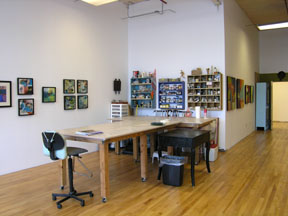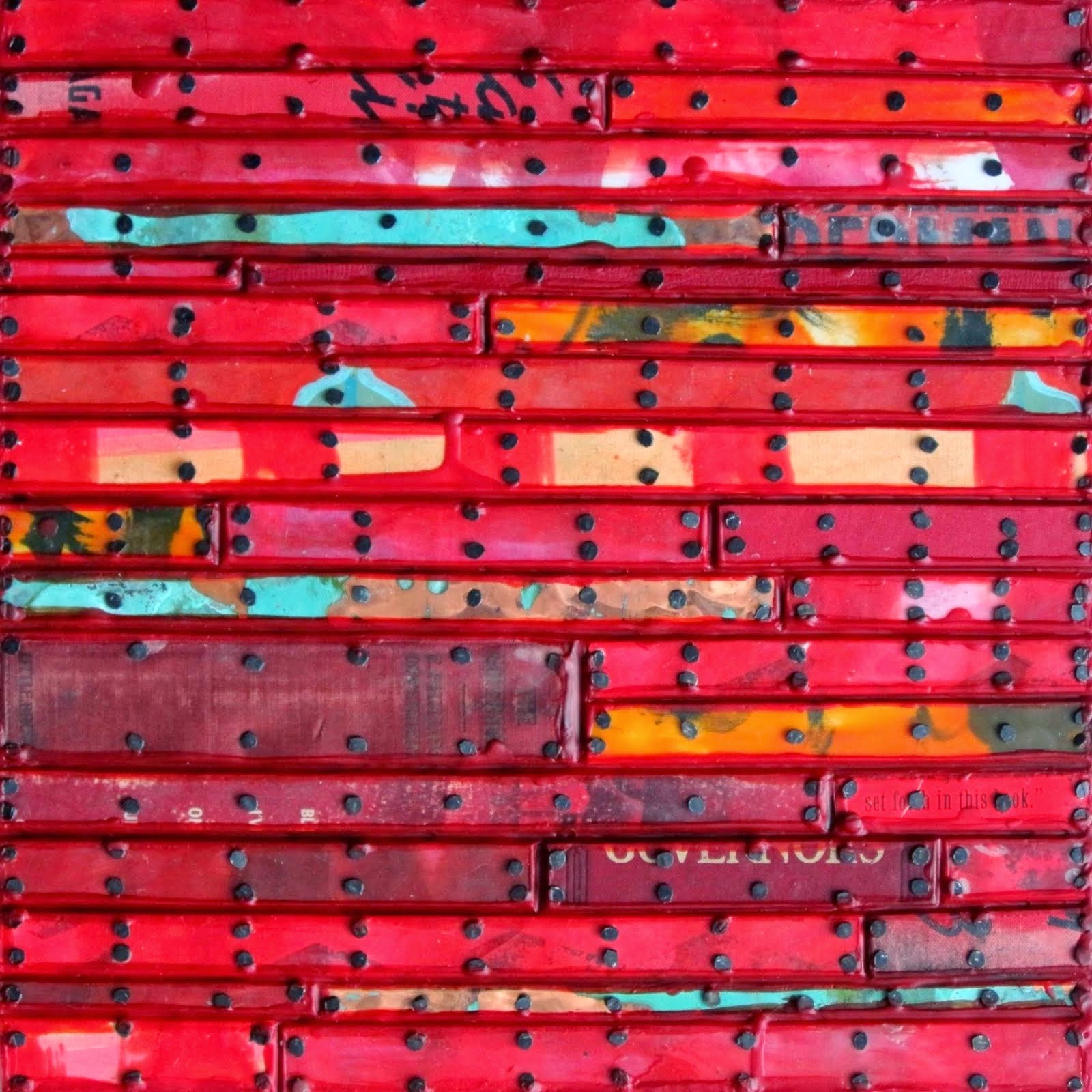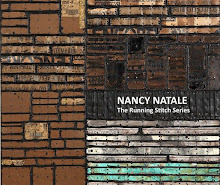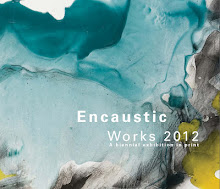
Rothko in his 69th Street studio with the Rothko chapel murals, 1964, photo by Hans Namuth from the National Gallery site.
Hope and Fear
These emotions are so intimately connected and reflected in the trajectory of Rothko's career. You know the cliche about being careful what you wish for. After struggling in poverty and disregard for so many years, Rothko finally made it. He was at the top of the Abstract Expressionist echelon, collected and shown world wide, rich and sought after. But when you reach the top, there's just one direction remaining.
Pop Arrives
In 1962 the Sidney Janis Gallery exhibited "the New Realists", a large number of international works that included Americans Jim Dine, Robert Indiana, Roy Lichtenstein, Claes Oldenburg, James Rosenquist, George Segal and Andy Warhol. In protest against this show, Adolph Gottlieb, Philip Guston, Robert Motherwell and Mark Rothko all withdrew from the Janis Gallery. Pop art had arrived and they wanted nothing to do with it.
Big collectors started selling the Ab-Ex works they owned and buying Pop. Rothko told a friend that he felt like he was dead; he was no longer hot, no magazines mentioned him and no young artists even tried to visit him. In America, Rothko said,"one can never become a patriarch, one simply becomes an old man." Breslin notes that the new element in the art market was the media. Rauschenberg, Johns, Stella, Oldenburg and Warhol were able to hit the top quickly and knock out the Ab-Exers without the decades of poverty and struggle that their predecessors had invested. Commercial success rather than philosophy drove many new artists, and the line between popular culture and art was erased.
Frank Lloyd and the Marlborough Gallery
Just as commerce drove the new artist, it also drove the new dealer. Frank Lloyd (who named himself after Lloyd's Bank) was the first to bring "a 20th century-multinational style" to art sales in New York with his Marlborough Gallery. He had successfully developed and used this business philosophy with the Marlborough Gallery in London. Lloyd's aim was not to promote art or artists because he believed in it or them, he was out to make money: "Many dealers are hypocrites - they say we're here to educate the public," Lloyd said, "I don't believe it. For a business, the only success is money."
Lloyd brought new advertising and marketing techniques to the art market. He offered his artists (who were already well-known, not emerging) long-term contracts, international exposure, color catalogs, higher prices, and services such as secretarial help, legal and tax advice, accounting, real estate and travel assistance, estate planning, etc. In return, he upped the traditional one-third commission to fifty percent. (Today, the commission percentage remains but the services have disappeared.)
Bernard Reis
Lloyd's entry into the world of successful New York artists was via a man named Bernard Reis. Reis was an accountant who befriended a lot of the big name Abstract Expressionists including Rothko. He also worked for theatre people such as Edward Albee and Joshua Logan, writers such as Lillian Helman and Gore Vidal and for collectors such as Peggy Guggenheim. Reis particularly liked artists, according to Breslin. He did artists' taxes, referred them to doctors and lawyers, set up estate plans and financial investments and offered any other kind of help they needed, generally making himself invaluable. From time to time artists gave him paintings in appreciation, but he never charged for his services.
Breslin says that by allowing Reis to take care of all the business details, the artists "could sustain their belief in a strict boundary between nasty business and high art." This arrangement made the artists dependent on Reis, and he became the middleman between them and their dealers, looking after the details of contracts. Reis encouraged dependency as it gave him more power and influence. Reis played an important part in the Rothko story - both before and after Rothko's death.
Marlborough Takes Over
Reis made the introduction to Frank Lloyd for Rothko, as well as for Guston, Kline, deKooning and Motherwell. Just prior to the Marlborough Gallery's New York opening in 1963, Rothko agreed to sell them 15 paintings for a little under $148,000 (a little less than $10,000 a piece). The paintings were to be marked up 40 percent and sold in the European market. Rothko would be paid four annual payments of $37,000 from 1965 through 1968. Rothko would continue to sell paintings in New York himself, from his studio.
This agreement was totally contrary to the way Rothko had previously sold his work. He was very careful to whom the work was sold, and he rationed sales so that his prices would be sustained. Breslin says that Lloyd flattered Rothko, who needed flattering at that point, and Reis advised him that the Marlborough sale would benefit him financially by allowing him to save on taxes and secure his income for four years.
 Untitled 1964 (from the National Gallery site).
Untitled 1964 (from the National Gallery site).The Rothko Chapel
Rothko's last one-man show in New York during his lifetime was at MoMA in 1961. He continued to paint but wanted to place his paintings in groups, rather than making single sales. He told a friend that all that really mattered to him were public commissions.
Rothko signed a $250,000 contract with the de Menil family in 1965 to produce a set of murals for a chapel in Houston. Rothko's friend, Dore Ashton, thought it was strange that Rothko would paint murals for what was at first to be a Catholic chapel, but after talking about it with him, she had a better understanding of his motives. "What is wonderful about Mark," she wrote in her journal in 1964, "is that he aspires, and is still capable of believing that his work can have some purpose - spiritual if you like - that is not sullied by the world."
The de Menils were French, rich from oil money, and art collectors who loved art for itself and not for investment value. They had bought their first Rothko painting in 1957. They gave Rothko a free hand in creating the murals for the chapel, which was to be designed by Philip Johnson. Johnson and Rothko disputed contrary visions of the building and the murals' prominence in it until, finally, in 1967 the de Menils got Johnson to resign. The architectural team that took over followed Rothko's intentions in making the building facade "blank, mute and rectilinear." Inside, he wanted the building to resemble his studio.

Interior of the Rothko Chapel showing three of fourteen panels. (panels are about 5' high x 15' wide)
Rothko worked for more than two years on the project with studio assistants who prepared the canvases and hoisted the heavy paintings for him. Some of the canvases were built up with fifteen or twenty layers of paint, according to one assistant. After a monochromatic base color was finally achieved to Rothko's satisfaction, Rothko decided on the sizes of rectangles to be painted on the colored fields. A rectangle was marked off with masking tape on a painted canvas and then colored in with charcoal. After studying the proportions and gradually enlarging the black rectangle, Rothko would call for another prepared canvas and paint in a black rectangles himself after having the precisely-taped size he had worked out duplicated on the new canvas. These were his first works with hard edge elements. Some of the panels did not have rectangles painted into them and were presented as Rothko's first monochromatic works.
Rothko notified the de Menils that the murals were completed in April 1967. The de Menils approved of the work - to Rothko's intense relief - and the panels were placed in storage at the end of 1967 while the building was completed. Rothko planned to oversee the installation of the work, but by the time the building was ready in 1971, Rothko was dead. The installation was created according to notes and plans that Rothko had supplied but was not subject to the adjustments that Rothko would certainly have made. He had actually made eighteen panels with four spares that could be interchanged when the installation was being completed.

Another view of the chapel showing the rear wall with two doors lit from the foyer.
Breslin spent five days at the chapel looking at the work. He sums up his study as follows: "Intended for a Catholic chapel, hung in an ecumenical one, these murals are spiritual only in the sense that they renounce the world - the world of material objects, of historical time and social pressures. Decorating a public, sacred space, they express a private and very human desire: a despairing wish to withdraw from the human."
 Dervishes at the Rothko Chapel, 1978. (from the Rothko Chapel site)
Dervishes at the Rothko Chapel, 1978. (from the Rothko Chapel site)Approaching the End
In April 1968 Rothko suffered a "dissecting aortic aneurysm" caused by hypertension. He was also found to have arteriosclerosis, an abnormal electrocardiogram and early cirrhosis of the liver along with the high blood pressure and what were actually three inoperable aneurisms. He was hospitalized and then confined to bed at home for several weeks. He was not allowed to paint, drink, smoke or eat the food he was used to. He experienced severe depression at his deprivation and the reality of impending death which could strike at any time.
After a hiatus from painting of two or three months, Rothko began working again. His doctor had told him not to work on anything bigger than 40 inches, but he gradually worked up to 72" x 60". After working so hard on the Chapel murals, he was at a loss for how to continue. He had begun working in acrylic on paper when planning the Chapel murals, and he now took that medium up again, working in acrylic until the end of his life. He worked "very fast" on these pieces, sometimes working on 15 of them at a time, and considered them disposable. His assistant described the process as "either it's there or he tears it up." He created two series in the last year of his life - Brown on Grey, acrylic on paper, and Black on Grey, acrylic on canvas.
 An acrylic on paper work from 1969 - one of the Brown on Grey series. Rothko considered the white margins where masking tape had held the paper to the wall to be an important element. "The dark is always at the top," is the way Rothko described them.
An acrylic on paper work from 1969 - one of the Brown on Grey series. Rothko considered the white margins where masking tape had held the paper to the wall to be an important element. "The dark is always at the top," is the way Rothko described them.
Rothko was unable to stay away from alcohol and began drinking heavily again. Continuous "fierce, bitter fights" with his wife, who also drank heavily, escalated to the point that he moved out of their home and set up a living space in his studio. He lived alone for the last fourteen months of his life in a "sparsely and shabbily furnished" room at the front of his studio with a couple of couches from the Salvation Army, a bed and a table. His only amenity was a stereo and some records.
Marlborough Digs Deeper
Over the years Rothko had had several close friends but had split with them over various disputes. In his last months, his two closest friends were Bernard Reis and Theodoros Stamos, an artist who, along with Reis, was made an executor of Rothko's estate.
In February 1969 Rothko signed a second contract with the Marlborough Gallery making it his exclusive agent for the next eight years and selling 87 of his works to them (26 on canvas, 61 on paper) for $1,050,000 to be paid over ten years (later extended to 14). That he had signed a contract for more than a million dollars gave Rothko a boost. But, Breslin points out that although Rothko thought he was saving money on taxes by having the payments stretched out, the Marlborough Gallery paid him no interest and that brought the income down to around $680,000. This arrangement also did not take into account the rising prices for Rothko's work, which benefitted the gallery, not Rothko.
Breslin points out that Rothko did not value the accumulation of things or a life of luxury. He was a child of poverty and the Depression and lived very frugally. He had no investment plan but deposited excess income in several savings banks ($132,000+ was found in nine banks after his death).
Although Rothko had signed a second contract with Marlborough, he and Frank Lloyd did not get along. In addition, the gallery was not promoting and selling his work as they had claimed they would and, in fact, as Rothko discovered, they were violating the contract by secretly selling work in New York (not solely in Europe) and at prices other than agreed for particular paintings. Rothko had talked with Arnold Glimcher of Pace Gallery about switching to them, but apparently Reis's hold over Rothko was such that he did not dare to leave Marlborough against Reis's advice.
 A late photo of Rothko in his studio.
A late photo of Rothko in his studio.Suicide
Rothko's body was found on the morning of February 25, 1970 by his studio assistant. Rothko had taken two bottles of antidepressants and sliced the inside of his elbows with a razor blade. He did not leave a note.
Breslin believes that at the time of his suicide, Rothko had lost confidence in Bernard Reis. He felt that Reis was steering him in the wrong direction by getting him to sign yet another contract with Marlborough for more paintings to be sold to them. These paintings were to be selected from Rothko's warehouse on the morning that Rothko's body was found. Breslin surmises that Rothko was so dependent on Reis that he didn't know how he would live without him. At the same time, he felt that Reis was manipulating him into doing things he didn't want to do such as leaving his wife and continuing to contract with Marlborough.
The Foundation and the Lawsuit
At the time of Rothko's death, his daughter Kate was 19 and living on her own in Brooklyn while attending Brooklyn College. His son was just six years old. Six months after Rothko's death, his wife Mell dropped dead from a heart attack, leaving the two children to manage on their own. Although they had inherited the family home and its contents, Rothko's inventory of nearly 800 paintings in storage was left to the foundation he had established in June 1969. The directors of the foundation included Bernard Reis, also an executor of Rothko's estate along with Theodoros Stamos and Morton Levine.
It turned out that the executors had close connections with the Marlborough Gallery and had made a secret deal to sell all 798 paintings in Rothko's estate to that gallery.
Rothko's daughter Kate Rothko Prizel and son Christopher Rothko sued the executors of the estate in 1971 in a case that dragged on for four years but was finally decided in their favor. They were awarded the return of the paintings and $9 million in damages. All contracts with the Marlborough Gallery were void. Paintings that Marlborough had already sold, however, were not returned.
Rothko's Children
From 2008 to February 2009 the Tate Modern in London had a show of Rothko's late work including nine of the Seagram murals that they own and that were gifted to them by Rothko himself. These works were reunited with other works from the Seagram murals series that are owned by the Kawamura Memorial Museum in Japan. Both Rothko's children attended the show that honored their father's work. (Both are doctors - Kate a pathologist and Christopher a psychologist.)
The Rothkos have recently published a book from a manuscript of their father's that they believe he wrote during 1940-41 when he claimed to have stopped painting. The book is titled
The Artist's Reality: Philosophies of Art. They have also released a DVD entitled,
Rothko's Rooms.
 Christopher Rothko at the Tate Modern show - wearing colors that his father would have appreciated. (Photo by Shaun Curry of AFP/Getty)
Christopher Rothko at the Tate Modern show - wearing colors that his father would have appreciated. (Photo by Shaun Curry of AFP/Getty) 



 Dervishes at the Rothko Chapel, 1978. (from the Rothko Chapel site)
Dervishes at the Rothko Chapel, 1978. (from the Rothko Chapel site)
 A late photo of Rothko in his studio.
A late photo of Rothko in his studio.








4 comments:
having been touched many many times by mark rothko's paintings, i have to thank you for your blog here. i happened across it while googling for info about rothko, about his death and then, ultimately, about his life. i recently saw rothkos at moca, in los angeles (where i live,) with an old friend. i did not cry this time, while viewing the paintings, but i have -- curiouser and curiouser -- often. so again, i thank you for your well written and detailed work. i learned a lot. flame simon
thank you
Thank you kindly. Your economy of language and penetration into the history was very much appreciated. (:
love Rothko, thanks for this!
Post a Comment